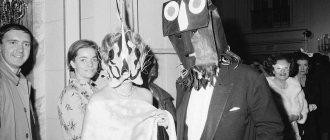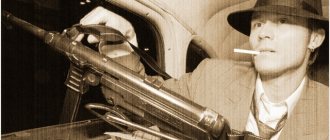US gangsters are known far beyond America. Films are made about them, and there are many legends about their activities. All of them were distinguished by intelligence, cunning and special cruelty.
The era of gangsters began with the adoption of Prohibition in the United States. It was then that street gangs began to appear in America. The innovation sparked underground activity. It was then that one of the most famous gangsters, Al Capone, began to act. He controlled the black market for alcohol. Later, other gangs began to appear that controlled different areas: prostitution, the sale of weapons, drugs. The gangs constantly fought with each other, trying to become the main ones. Here are a few representatives of that legendary and cruel time for the United States.
Gangster stories
Gavin Veshala, an enthusiastic photographer from Buffalo, decided to revive the odious bandits with color, because you should know not only the heroes by sight, but also the villains, which the presented characters certainly are. Attached to each photo is a short account of the illegal exploits of these notorious bandits, robbers, and murderers.
Al Capone
Al Capone (Alphonse Gabriel "Great Al" Capone). The main mafioso in the history of Chicago, murderer, bootlegger, racketeer, who ended up getting burned for tax crimes. Extremely popular among filmmakers who made numerous television series, feature films and documentaries about Capone and turned him into the most famous gangster in history. Alphonse's big mafia career lasted from the mid-1920s to May 1932. Participation in the infamous St. Valentine's Day Massacre remained an unproven episode of the criminal biography, and the Chicago robber was imprisoned for tax evasion, receiving eleven years in prison. Behind bars, the mafia boss's poor health was undermined, which was the reason for his early release in the fall of 1939. However, only the shadow of the villain, whom the whole country once feared, was released. Syphilis, gonorrhea, stroke, pneumonia and cardiac arrest January 22, 1947. Interesting articles
- The most fashionable dances of the 1960s
- Fashionable clothes of the 80s in the USA (men's and women's)
- History of the NBA logo
- Who are the Beats - history and photographs of the Beat Generation
Joe Adonis
Joe Adonis. Joseph Anthony Doto is the closest associate and assistant of the legendary Lucky, on whose orders Adonis participated in the murder of Joe Masseria. In addition to hired murders, Adonis (the Italian dandy and handsome man changed his family name so that no one would doubt who in New York is a relative of the Mediterranean God of love) was engaged in racketeering, gambling, alcohol smuggling, prostitution, leading the most powerful gang in Manhattan - the Broadway grouping. Despite the huge number of crimes, the famous criminal avoided arrest for a long time, going to jail only in 1951, after which the bandit was deported from the United States, having managed to prove that he was born in Italy, and therefore was never an American citizen. Here in Milan, Italy, a pensioner died when his heart stopped during a police interrogation. Adonis outlived his comrade Luciano by ten years, dying in the fall of 1971.
Lucky Luciano
Lucky Luciano (Charles "Lucky" Luciano).
Salvatore Lucania is a cunning, cunning, unscrupulous criminal who is considered the founding father of organized crime in the United States and a legend in worldwide criminal history. He first went to prison in 1916, after which he finally chose the criminal path for himself, going through a long dramatic path from an ordinary mafia fighter to a leader and reformer. Charles received the famous nickname “Lucky” (Lucky) when he managed to survive an attack by competitors who kidnapped a gangster, took him to a quiet place, beat him half to death, but unfortunately did not finish the job. Charlie will not make such mistakes again, he will always strike first, leaving no chance for his enemies to escape. The famous episode from the film “The Godfather,” when the killers simultaneously eliminate all the enemies of Al Pacino’s character, is taken from the biography of this criminal genius, who in the early 1930s rose to the rank of top mafia boss and founder of the still active Genovese clan. Even once again imprisoned, Lucky continued to lead the criminal empire and even helped the US armed forces conduct a successful military operation in Sicily in 1943, for which he was granted an amnesty and deported outside the country. He settled in Italy and died of natural causes in the winter of 1962, which is an extremely rare occurrence for representatives of the gangster trade.
Albert Anastasia
Albert Anastasia.
Humberto Anastasio, aka the Mad Hatter, was the founder of the Gambino family and is known as one of America's most brutal mobsters. When Lucky assumed the supreme place of criminal life in America, the reformer's first innovation was the division of labor to increase efficiency. Among others, a liquidation department was formed - the so-called Murder Corporation, headed by Anastasia. The killer committed his first murder back in 1921, for which he received a death sentence. But the high-quality work of the lawyers, together with the failure of all witnesses to appear at the court hearing during the retrial of the case, led to the overturning of the sentence and the gangster’s release to freedom, where the killer was awaited by new crimes and the post of head of the Murder Corporation. Like many other representatives of the United States mafia, Anastasio was born and raised in Italy, from where he moved to the promised lands. In gratitude for his exemplary service in the armed forces and participation in World War II, the States granted citizenship to the bandit. When Lucky, Doto, and other crime bosses of Italian origin were expelled from the country, Anastasio managed to stay in the States, founded his own family, where another strong leader subsequently appeared, who gave the order to eliminate the founder. The mafioso was shot dead in a barbershop on October 25, 1957.
Frank Costello
Frank Costello.
Francesco Castilla is a kind of Prime Minister of the criminal underground empire, a business partner and leading member of the Lucky Lucky clan, who became the head of the organization when the leader went to prison. The most intelligent, balanced, cold-blooded criminal, who received the position of consigliere for his ability to speak beautifully and listen carefully. A native of Calabria moved to the United States as a four-year-old child, as a 13-year-old teenager he joined a street gang, and by the age of 17 he was already prosecuted. At 24 (1915) he went to prison for six months for illegally carrying weapons. Having been freed, Costello, in his own words, never took up arms again. Acquaintance with the main criminal celebrities opened numerous doors for the future consigliere, providing the necessary opportunities, which Costello took full advantage of. Politicians, judges, and police officials enjoyed communicating with the mafia consigliere, because Frank dressed tastefully, spoke intelligently, and generally behaved not like a street thug, but like a skillful negotiator with whom it was interesting to deal. His talent for diplomacy helped the criminal survive the gangster wars, get out of problems with the law, and successfully retire in the 1950s, retaining his income from the gambling business and living out his life in retirement. He died of a heart attack in the winter of 1973.
Carmine Galante
Carmine Galante. The gangster who led the Bonanno family is an extremely cruel, uncompromising, bloodthirsty mafioso, with more than a hundred personally committed murders to his name. From the age of ten he was in the correctional system, having begun to show criminal tendencies in the first grades of school. Carmine was tried several times for various petty crimes, until in 1930 the killer faced a fierce shootout with the police, as a result of which a little girl was wounded, who turned out to be a bystander to a botched robbery. Participation in the attack on the bank cost Galante twelve years - the killer was released in 1939, continuing his gangster career and gradually rising to the status of a respected authority. He received a prison sentence several more times and was again released, where the honored robber was eliminated on July 12, 1979, shot along with the guards on the terrace of his favorite restaurant.
Vito Genovese
Vito Genovese.
Another Italian thug who made a dizzying career on American soil. Don Vito, the leader of the clan of his own name, was an ally and closest assistant of Lucky, having received the mafia throne of his comrade when Lucky was imprisoned. The rise of Genovese began with the murder of Masseria and continued over the next decades, when competitors were eliminated and brothers in arms ended up in prison or hid from the law by moving to their historical homeland. Don Vito himself did not escape a similar fate, leaving for Italy in 1936, where he spent a whole decade. When Genovese returned to America, he immediately began to regain his lost positions, competing with Guarino Moretti for the title of second man in the mafia. Costello remained first until his retirement. But when this happened, Vito received a large sentence for drug trafficking, which in the case of the advanced age of the retired bandit (63) actually meant life imprisonment. The drug dealer served ten of the required fifteen, dying in the prison hospital on February 14, 1969.
John Dillinger
John Dillinger (John Herbert Dillinger).
An odious robber, raider and murderer, who in the 1930s received the loud nickname Public Enemy Number 1. The Italian-American mafia was involved in smuggling, gambling, bootlegging, racketeering, drug trafficking, prostitution and tried not to appear in front of representatives of law and order. The real American Johnny Dee robbed banks, killed policemen who stood in his way, for which he quickly became the country's main bandit. Car theft became the premiere crime for a young man who avoided prosecution by joining the navy. However, the hooligan did not like army life, so John served only five months and ran away from the army, returning to crime. Robbery, prison, amnesty, another bandit raid. This time a bank robbery, which will become the signature style of Dillinger and his accomplices. The FBI organized a special group to arrest or eliminate the robber-murderer, who avoided meeting with the lawmen until July 22, 1934. On this day, John and his girlfriend decided to go to the cinema, at the exit of which a team of federal agents was waiting for the robber. The feds did not offer the criminal to surrender - they riddled him with bullets and put an end to the terror of the odious criminal.
Dancing and ending the evening "Chicago 30s"
You can end the evening with grand dancing. But there is no dancing without music - and it must be selected with the utmost care.
The 30s were the time of jazz. It is not at all necessary to focus on the old sound. There are many modern arrangements that will create the right mood without sounding like something from the distant past.
For the musical design of this party, music in the style of jazz, foxtrot, and soft, soothing sounds of the saxophone will be suitable. You can include compositions by the immortals Frank Sinatra and Louis Armstrong.
Red carpet for welcoming guests
As you know, celebrities, and only such guests will attend the event today, love to be greeted with style and pomp. At the entrance, you can arrange the first photo zone - a red carpet, where guests will be greeted by a real journalist with a large camera and a blinding flash.
It’s good if the journalist is dressed appropriately: a dark suit, possibly a tuxedo and definitely a hat. The journalist’s task is to capture the guests as vividly as possible, to capture even fleeting moments from the lives of celebrities.
If you immediately set your camera to black-and-white or sepia format, at the end of the party you can give each participant his photo, printed on a home photo printer.
We are sure that your friends will be pleasantly surprised and will remember the event for a very long time.
Chicago '30s Party Clothes
This party is themed and an important component is the dress code.
Women should choose dresses below the knee with a dropped waistline. It can also be a long fitted dress made of flowing fabric.
Accessories will help you create your look.
In the thirties, it was almost impossible to meet a woman without strings of beads around her neck; in addition, every representative of the fair sex had a small, neat hat.
It is best to style your hair in soft waves and add shine with hairspray.
Men should look like women, so the ideal solution for them would be a three-piece suit, a hat and a classic thin scarf. Combed, varnished hair and a thin mustache (even if you draw it with a pencil) will go well with all this.
We are against smoking, but a cigar will complement the image (only for beauty, no smoke).











